When IBEW 1245 member Edward Gill hired on at the Moss Landing Power Plant more than four decades ago, it looked and ran quite differently than it does today.
“When I started in ’79, the facility was owned by Pacific Gas and Electric. And operation was a little different, because a lot of the guys who worked here were out of the service, either the Navy or the Marines … So it was kind of run like a ship. It was interesting,” Gill recalled. “I started on the old boiler side, and it was all manual controls. There was no computer system, just operator experience working on it.”
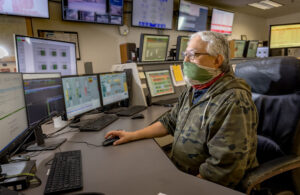
Power Plant Tech Edward Gill
The job — and the plant itself — have changed and evolved quite a bit over the years. Gill recalls the first time her worked on units with a Westinghouse computer, and later, on the more high-tech FoxPro and GE systems. He’s seen all sorts of technological advancements come to the plant to improve efficiency and reduce emissions over the past four decades – and earlier this year, his longtime worksite gained international notoriety when it became home to the largest lithium-ion battery storage system in the world.
The 300 MW/1,200 MWh lithium-ion battery storage system at Moss Landing (which is owned by Vistra) was installed by members of IBEW 234 out of Castroville, and is now being maintained by Gill and the other IBEW 1245 technicians who work for Vistra at Moss Landing. Made up of nearly 100,000 batteries split into more than 4,500 stacked cabinets, the system has the capacity to power approximately 225,000 homes for about four hours during peak electric usage times. Phase II of the battery storage project will bring an additional 100 MW/400 MWh to the facility by late summer of this year, for a total capacity to 400 MW/1,600 MWh.
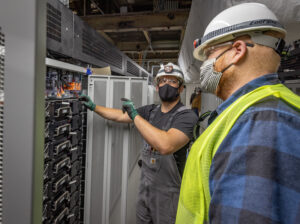
Nicholas Covello (left) and Lee Phillips check batteries
Utility grid-scale storage has been the missing link in the renewable power puzzle for many years – but now, with Moss Landing’s groundbreaking storage capability, California will be able to utilize more greenhouse-gas-free power, bringing the state closer to its ambitious clean-energy goals.
“The North American power grid is the most complicated and expensive machine in human history. It is also the most important to our economy, but it wasn’t designed for intermittent generation like solar and wind,” said IBEW International Utility Director Donnie Colston. “Grid-scale storage is not only one of the ways we bridge that gap, but like at Moss Landing, it is evidence than decarbonizing power generation can provide good jobs.”
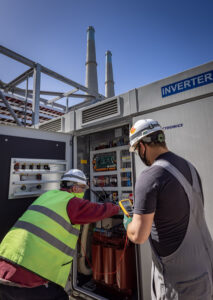
Nicholas Covello (right) and Jaime Rivera check voltage on the inverters
“Our members at Moss Landing are a prime example of what a ‘Just Transition’ to a clean energy future can look like when workers – backed up by a strong union – are given the opportunity and training to evolve their skills and jobs in conjunction with the shift towards more renewables,” said IBEW 1245 Business Manager Bob Dean. “We don’t need a Green New Deal; we are the Green New Deal.”
***
Plant Technician Caleb McNutt, a 20-year IBEW 1245 member, hired on back when the plant was owned by Duke Energy. He explained how the team at Moss Landing works to make use of California’s surplus renewable power without sacrificing reliability.
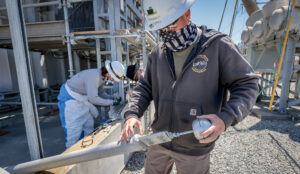
Power Plant Tech Caleb McNutt
“The batteries pull in power when we’re producing excess power from, say, wind and solar, and we store that for times when wind and solar is not as plentiful, and we’re able to push that back out onto the grid,” McNutt told the Utility Reporter. “We’re trying to kind of smooth out the peaks and valleys of the grid, making it more stable.”
“We have what are commonly referred to as inverters … usually, an inverter only takes AC to DC, but we have inverters that will also take DC to AC,” McNutt added. “The electricity goes both ways through these inverters, and converts it to AC when it’s going out on the grid, and it converts it to DC when it comes in and charges the batteries.”
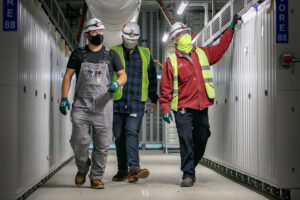
Nicholas Covello, Lee Phillips and Jaime Rivera walk down a bank of batteries
Gill, who has watched the plant change ownership five times over his 41-year career, recognizes the value of IBEW 1245 representation in making sure he and his co-workers are protected.
“I’m glad the union’s there, because we get a lot of benefits from the union, and they watch out for us … so we’re not being walked on by any company,” he said. “They’re the voice that has helped us with negotiation for our benefits. As today goes, a lot of employers are really backing off on what they want to cover … so I’m glad to be a union member.”
“The union has given me a great opportunity here. It supports my family, and it’s a well-paying job,” added McNutt. “It’s very seldom in this area to find a good paying job like this.”
For many years, the members at Moss Landing have been concerned about the uncertain future of the plant. When two of the units were retired in 2016, and the potential for a plant closure was looming, the union worked with the members to shore up severance options and successor language. But in just five short years, the plant came back from the brink and is now a beacon of hope.
“With the installation of the battery storage facility, and the new direction that Vistra is taking with clean energy, the future of the Moss Landing Power Plant appears more promising,” said Assistant Business Manager Al Fortier. “The workforce is now expanding again, we have a newly negotiated contract with many improvements, and the members are more optimistic about their future.”
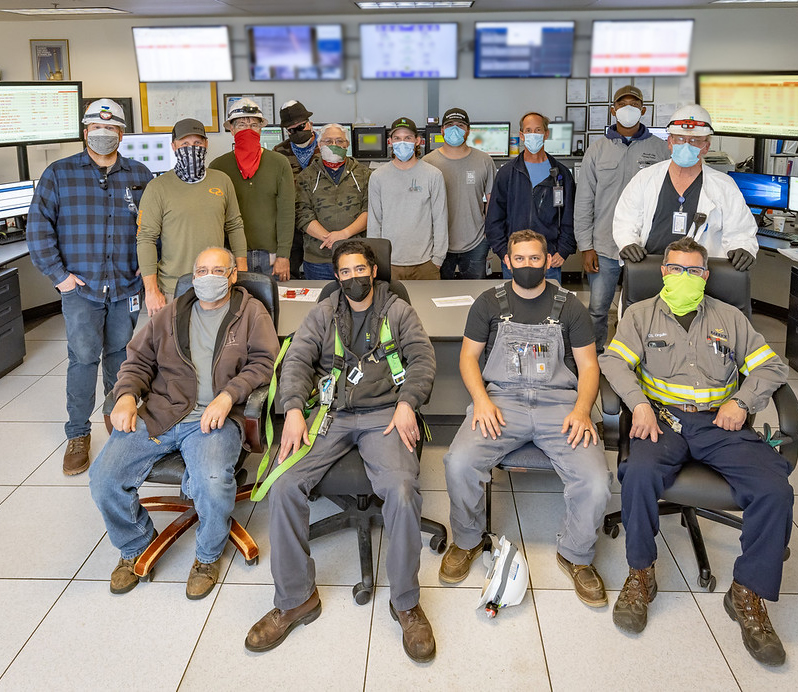
IBEW Local 1245 members working at the Moss Landing: Richard Carrillo, Isaac Henry, Nicholas Covello, Jaime Rivera, Lee Phillips, Caleb McNuttt, Craig Smith, Edward Gill, Weston Miller, Noah Short, Eric Gruber, Franklin Pringle, Bill Bailey, Doug Bailey.
READ MORE ABOUT THE BATTERY INSTALLATION AT MOSS LANDING (VIA IBEW.ORG)